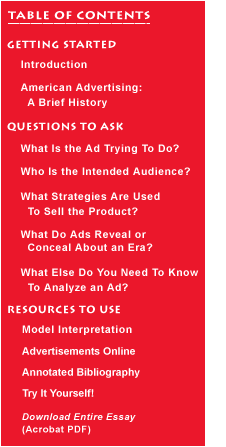|
Berger, John. Ways of Seeing. London: British Broadcasting
Corporation and Penguin Books, 1972.
Berger, an artist, critic, and novelist, presents insights about imagery
and how we view it. This is an influential work that analyzes advertising
with the tools of both an art critic and a cultural historian.
Ewen, Stuart. Captains of Consciousness: Advertising
and the Social Roots of the Consumer Culture. New York: McGraw-Hill,
1977.
A stimulating and original study that views the advertising as crucial
to the displacement of class conflict and inculcation of consumer consciousness
when distribution, rather than production, became the fundamental problem
of capitalism.
Fox, Stephen R. The Mirror Makers: A History of American
Advertising and Its Creators. New York: Morrow, 1984.
A popular and well-informed overview that contends that at times advertising
reflected American culture, at other times helped to shape it.
Frank, Thomas C. The Conquest of Cool: Business Culture,
Counter Culture and the Rise of Hip Consumerism. Chicago: University
of Chicago Press, 1997.
A biting (and very funny) critique of advertising and marketing in the
sixties and beyond. Frank contends that businesses fostered seemingly-radical
themes of individual freedom and revolt against conformity because they
fit corporate interests.
Glickman, Lawrence B., ed. Consumer Society in American
History: A Reader. Ithaca, NY: Cornell University Press, 1999.
An excellent collection of writings on consumption ranging from theoretical
insights to empirical studies and covering topics dealing with early European-Native
American contact to contemporary issues.
Goodrum, Charles and Helen Dalrymple. Advertising in
America: The First Two Hundred Years. New York: Harry N. Abrams, 1990.
A lavishly illustrated history of American advertising. Although the authors’
tone is generally positive, their book is well-researched and they include
some pointed criticism of advertising practices.
Laird, Pamela Walker. Advertising Progress: American
Business and the Rise of Consumer Marketing. Baltimore: Johns Hopkins
University Press, 1998.
A carefully researched study of advertising in the late nineteenth and
early twentieth centuries. Laird emphasizes the theme of progress—economic
and cultural—that advertisements espoused and that advertising practitioners
adopted as an ideology.
Lears, Jackson. Fables of Abundance: A Cultural History
of Advertising in America. New York: Basic Books, 1994.
An innovative and learned survey. Less interested in the business context
of advertising, Lears maintains that we have lost a sense of the magical
and enchanted properties of the material world as advertising offers us
an abundance associated with the mechanistic and confining world of the
factory and the office.
McLuhan, Marshall. The Mechanical Bride: Folklore of
Industrial Man. New York: Vanguard Press, 1951.
A pioneering work by the provocative and controversial Canadian media
expert. In this early work, McLuhan presents stimulating, sometimes mystifying,
commentary on advertising imagery in mid-twentieth century America.
Marchand, Roland. Advertising the American Dream.
Berkeley: University of California Press, 1985.
Marchand’s study of advertising in the 1920s and 1930s is a model
for its integration of business and cultural history and for its masterful
analysis of both the copy and the artwork of magazine advertisements of
that era. He was also the author of the posthumously-published Creating
the Corporate Soul: The Rise of Public Relations and Corporate Imagery
in American Big Business (Berkeley: University of California Press,
1998), which has many insights on advertising campaigns to enhance corporate
reputations.
Ohmann, Richard. Selling Culture: Magazines, Markets
and Class at the Turn of the Century. London and New York: Verso,
1996.
In his analysis of new mass-circulation magazines in the 1890s, Ohmann
discusses how their emergence both reflected and promoted the formation
of a new kind of middle class in the United States. Advertising, both
as the economic foundation for these magazines and as a molder of class
and culture, figures prominently in his analysis.
Pope, Daniel. The Making of Modern Advertising. New
York: Basic Books, 1983.
This book views advertising from the standpoint of business history. It
contends that the basic structures of American advertising were molded
in the late nineteenth and early twentieth centuries by the rise of big
business.
Presbrey, Frank. The History and Development of Advertising.
Garden City, NY: Doubleday, 1929.
A celebratory history by an advertising man. Although it lacks a scholarly
approach, it is full of information and contains many illustrations.
Scanlon, Jennifer. Inarticulate Longings: The Ladies’
Home Journal, Gender and the Promises of Consumer Culture. New York:
Routledge, 1995.
An intriguing recent study that stresses the gendered nature of consumer
culture. Scanlon demonstrates that advertisements—as well as the
fiction and advice in America’s first mass-circulation women’s
magazine—portrayed a society where women would find meaning and satisfaction
in their lives through consumption.
Schudson, Michael. Advertising: The Uneasy Persuasion:
Its Dubious Impact on American Society. New York: Basic Books, 1984.
Schudson, an historical sociologist, raises significant challenges to
those who see advertising as an all-powerful social force.
Strasser, Susan. Satisfaction Guaranteed: The Making
of the American Mass Market. New York: Pantheon Books, 1989.
Strasser places the development of national advertising in its marketing
context, stressing its role in the development of mass produced, standardized
products.

|



